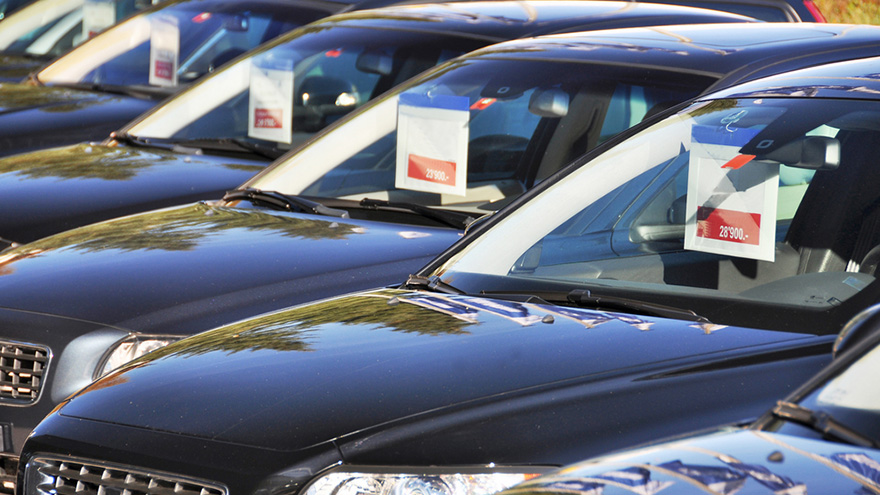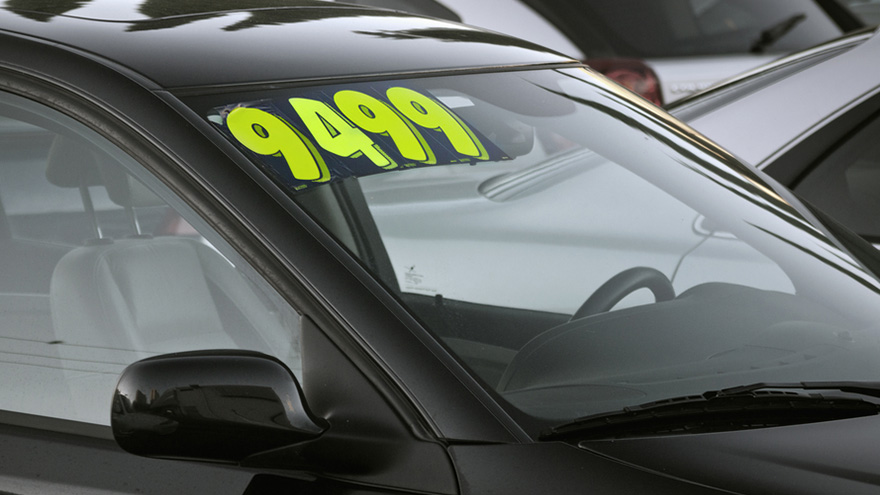Toyota and Honda auto dealers deliver the best customer experience in the country, according to a ranking based on a survey of 10,000 consumers released Thursday.
Of the 18 auto dealers included in this year’s Temkin Experience Ratings, Toyota earned the highest rating in the industry, and Honda followed closely behind in second place. Meanwhile, among the 20 different industries in the United States examined this year, overall, auto dealers experienced the sharpest customer experience rating drop.
“This decline is the result of double-digit drops from a few auto dealers,” Temkin Group managing partner Bruce Temkin explained in a news release.
This is the eighth year Temkin Group has evaluated over 300 companies for success, effort and emotion across 20 different industries.
A score of 70 percent or above is considered “good,” and a score of 80 percent or above is considered “excellent.” Scores below 60 percent are considered “poor.”
Toyota auto dealers earned a score of 73 percent, while Honda received a score of 72 percent. Additionally, both Ford and Mercedes-Benz auto dealers received a “good” rating with a score of 70 percent.
This year, the auto dealer industry averaged a rating of roughly 66 percent.
“Of all the industries we looked at this year, auto dealers saw the steepest drop in their industry average customer experience,” Bruce Temkin said.
With a drop from 68.6 percent to 65.6 percent, the average rating of the industry has declined by three percentage-points between 2017 and 2018.
The auto dealer industry holds the 12th place spot out of the total 20 industries ranked by Temkin Group.
The complete list of each auto dealer evaluated by Temkin Group is below, with their respective scores:
- Toyota: 73%
- Honda: 72%
- Ford: 70%
- Mercedes-Benz: 70%
- Chevrolet: 69%
- Hyundai: 68%
- Subaru: 67%
- Buick: 67%
- Nissan: 67%
- Cadillac: 66%
- Kia: 63%
- Dodge: 63%
- Jeep: 61%
- Mazda: 58%
- Audi: 56%
- BMW: 53%
- Chrysler: 53%
- CarMax: 43%
Tamara Darvish is embarking on another automotive industry endeavor.
Capital Automotive Real Estate Services — which orchestrates custom tailored financing packages for dealers — announced that Darvish joined the company as its new chief operating officer.
Capital Automotive highlighted that Darvish will use her knowledge and expertise to lead both the acquisition and real estate teams. The company insisted that she has achieved results in the past with her “bold execution, game-changing initiatives and ability to grow a business exponentially.”
Darvish most recently held the position of COO at Pentagon Federal (PenFed) Credit Union, where she spearheaded efforts to grow assets by billions by generating millions of dollars of origination growth each month.
Prior to her work at PenFed, she was the executive vice president at DARCARS Automotive Group. It was at DARCARS that she honed her skills in the automotive industry by growing the family business from three franchises to more than 20 dealerships, maintaining year-over-yer profitability, and serving on multiple industry boards and spending significant time advocating for dealers with members of Congress.
“Tamara brings with her an abundance of knowledge and experience in retail automotive and banking industries. She will be a great asset to our already outstanding team,” said Jay Ferriero, president and chief executive officer of Capital Automotive.
The relationship connecting the National Independent Automobile Dealers Association and KAR Auction Services is now even stronger.
On Wednesday, NIADA named Automotive Finance Corp. and TradeRev as Diamond-level National Corporate Partners — the association’s highest level of corporate affiliation.
AFC provides independent vehicle dealers a portfolio of trusted, flexible inventory financing and business solutions from more than 130 branch locations across the U.S. and Canada.
TradeRev is one of North America’s most advanced and longest-running digital mobile-app live auction platform for dealer-to-dealer transactions.
“TradeRev and AFC provide premier services that are directly aligned with the success of our independent dealer members and the future of our industry,” NIADA chief executive officer Steve Jordan said.
“These two businesses have a proven track record of delivering innovative products and services to help dealers quickly and conveniently source and finance inventory. And with the support of KAR Auction Services, we know they are here for our members — and here to stay,” Jordan continued.
Over the past year, NIADA highlighted TradeRev and AFC have collaborated to bring independent dealers first-of-their-kind promotions such as no floorplan fees and no-interest financing for 45 days for vehicles bought on TradeRev.
With the release of TradeRev 4.0, TradeRev became the first and only digital auction platform to introduce real-time AFC credit line availability displayed in-app, and fully integrated one-click AFC financing at checkout.
The partnership follows TradeRev’s recent unveiling of H, its artificial intelligence capabilities that combine the power of KAR’s data and TradeRev’s machine learning and predictive analytics to deliver clear, actionable information to dealers.
“NIADA dealers are smart, tech savvy and always looking for next-gen technology solutions to help their businesses grow and succeed,” KAR chairman and chief executive officer Jim Hallett said. “We are proud to partner with NIADA and to continue serving its strong membership.
“With a coast-to-coast presence and strong pipeline of innovation, TradeRev and AFC will help keep dealers moving and their inventory moving even faster,” Hallett continued. “Whether you’re an NIADA member in Buffalo, Los Angeles, Tampa or Dallas — you can count on TradeRev and AFC to expand your marketplace and extend your floorplan buying power.”
AFC serves the NIADA community in the retail and wholesale automotive space, as well as serving RV, power sports and commercial truck dealers, salvage buyers and daily rental operators, offering floor planning to independent vehicle dealers.
AFC provides liquidity, bandwidth, industry expertise and credibility and is accepted by more than 1,000 inventory sources.
TradeRev is a mobile app offering NIADA members fast, convenient access to high-quality trade-in and commercial consignment inventory before it reaches wholesale physical auctions. The TradeRev mobile app mimics the physical auction setting, enabling dealers to launch and participate in live, one-hour auctions directly from their smartphone, tablet or desktop.
Winning TradeRev bidders can complete the entire transaction within the app, including optional inspection, title and arbitration services, and AFC financing and transportation through CarsArrive Network, another KAR business unit.
Based on how the flow of tax refunds impact the used-vehicle market, Cox Automotive wasn’t surprised by the movement of wholesale prices in March.
According to Manheim Used Vehicle Value Index — a measure of wholesale prices adjusted for mix, mileage and season — wholesale used-vehicle prices decreased slightly in March compared to February. But March prices climbed 5.4 percent from year-ago levels.
At 130.8, the index is at its lowest level since July 2017, a point just prior to when Hurricanes Harvey and Irma began to impact the market.
“The marginal price decline in March was not significant,” said Jonathan Smoke, chief economist for Cox Automotive. “The slight decline in the seasonally-adjusted index value was the result of the adjustment process expecting more of an increase in March, but delays in tax refunds have shifted the peak of used-car demand by several weeks.
“Looking ahead, we are expecting strong pricing in April and May, as tax refunds more fully impact the used-car market,” Smoke continued.
Delving deeper into the March wholesale data, analysts found several segments with prices moving higher.
In fact, Manheim noticed every vehicle segment posted wholesale price increases compared to last year, with an especially strong gain once again in vans. First quarter wholesale price trends for all segments included:
— Compact car prices represent significant strength, with a 5.4 percent increase over 2017. That’s even more than the typically strong SUV/crossover segment.
— The midsize car segment was the weakest performer, but unlike previous quarters, the segment did not experience a decline, posting instead an increase of 0.9 percent over 2017.
— Pick-ups and vans both showed strength, with vans increasing significantly thanks to a 13.4-percent gain compared with March of last year. Manheim added that pick-ups had a comparatively modest increase of 5.5 percent.
—Wholesale pricing for SUVs and crossovers underperformed the overall market, increasing 5.1 percent from last year. Analysts explained the underperformance is likely due to an increasing supply of used SUVs and more aggressive pricing and incentive spending on new inventory.
— Luxury car values once again underperformed the overall market, increasing 4.1 percent over the same period last year.
Also of note, Manheim determined rental-risk pricing strengthened in March, with the average price for rental-risk units sold at auction up 7 percent over last year and 4 percent compared to February.
Analysts added the average mileage of 45,000 for rental-risk units in March was 13 percent higher than last year.
Correlating the used-vehicle market with the tax calendar
After plowing through the March wholesale pricing data, Cox Automotive returned back to a discussion about IRS activities and a recap of how retail sales landed in March.
Historically, Cox Automotive acknowledged used-vehicle sales in the U.S. have peaked in the weeks following the peak in tax refunds. Starting in 2017, however, the IRS delayed the point when households with eligible tax credits could file tax returns. This resulted in refunds being delayed by approximately four weeks, impacting used-vehicle sales and pricing.
“This same situation is impacting 2018, as well,” analysts said.
Used-vehicle sales in March increased 1 percent over year-ago levels, according to Cox Automotive estimates, with the month’s seasonally adjusted annual rate (SAAR) for used vehicles rounding out at 39.5 million units.
Since 2009, the average March increase relative to February in the Manheim Used Vehicle Value Index has been 3.5 percent, just slightly higher than the March 2018 unadjusted increase of 3.4 percent.
Analysts explained the historical bump in March pricing has been driven by an increase in used-vehicle demand driven by earlier tax refunds.
“The seasonal-adjustment process still expects to see this historical pattern in used-vehicle values,” Cox Automotive said. “As a result, the seasonally adjusted value for March registered the slight 0.15 percent decline.”
Through the week of March 23, Cox Automotive mentioned the cumulative number of refunds in 2018 is down 1 percent compared to 2017.
“The weekly trend in refunds, however, relative to last year, is now trending up, with experts predicting a stronger price trend in April as retail used-car demand will likely peak for the year,” analysts added.
Meanwhile, on the new-car side, Cox Automotive recapped that new-vehicle sales increased 6 percent year-over-year in March, coming in far stronger than forecast and surprising most analysts and experts.
The March 2018 new-vehicle SAAR of 17.4 million, up from 16.7 million in 2017, marked the seventh straight month of more than 17 million SAAR and the third best March on record.
“Cars continue to experience sharp declines in the market, with sales last month falling 9 percent compared to year-earlier levels. Trucks and SUVs continued to gain share,” analysts said.
The latest commentary from Comerica Bank also touched on new-vehicle sales, noting how challenging it is to project future figures.
“Forecasting auto sales is now a two-handed argument,” Comerica Bank chief economist Robert Dye said.
“On the one hand, strong economic conditions are supportive of ongoing auto sales,” Dye continued. “On the other hand, sales were declining through the first eight months of 2017, then came the surge in sales in September as a result of hurricane damage along Gulf Coast.
“We expect to see gradually easing auto sales this year,” he added.
Trends and economic momentum
Cox Automotive closed its latest index update by noting some general economic news.
Analysts mentioned the fourth quarter's real GDP growth rate was revised upward to 2.9 percent from its previous 2.5 percent.
“Expectations remain for a continuation of accelerated growth this year due in part to increased consumer spending and business investment resulting from recent tax reform,” Cox Automotive said.
“Despite consumer confidence last month experiencing a moderate decline from a 17-year high in February, largely due to stock market volatility, consumer spending expectations remain high due to tax cuts, strong wage growth and the robust labor market,” the company went on to say.
Dye also discussed an important component in dealerships turning vehicles — their customers having a job to generate income and pay their installment contract.
Dye explained the official federal employment data for March was “eye-catching” as firms increased employment by just 103,000 jobs on net, “well below consensus expectations” of about 185,000 for the month. He pointed out the miss in March payrolls comes on the heels of a robust 326,000 job gain in February.
“The March slump looks like mean reversion right now,” Dye said. “If it is followed by a weak April, that is another story, but other indicators point to ongoing moderate job growth this spring.
“The unemployment rate stayed at 4.1 percent for the sixth consecutive month,” he continued. “We still expect it to edge lower, but the rate of decline has clearly eased.
“Average hourly earnings increased by 0.3 percent for the month and are up 2.7 percent over the previous year,” Dye went on to say.
Along with recapping some of the full-year used-vehicle metrics he discussed during NADA Show 2018, KAR Auction Services chief economist Tom Kontos also pinpointed wholesale price movements for February.
According to ADESA Analytical Services’ monthly analysis of wholesale used-vehicle prices by vehicle model class, wholesale used-vehicle prices in February averaged $10,707, which was 2.5 percent lower compared to January and 0.2 percent higher relative to February 2017.
Kontos noted that sporty cars made the highest price jump in February, climbing by 4.5 percent.
He added that decliners were paced by full-size cars, which softened by 6.6 percent.
According to his presentation shared during the annual event hosted by the National Automobile Dealers Association, there was a 2.0-percent lift in used-vehicle transactions in 2017. The combination of turns at franchised and independent stores as well as deals made by private parties resulted in 41.38 million used-vehicle sales last year, according to Kontos.
The 2017 figure represented a jump of 827,000 units, with private sales constituting more than half of that amount. Here is a breakdown of the full-year figure:
— Sales at franchised dealerships: 15.1 million
— Sales at independent dealerships: 14.1 million
— Private party transactions: 12.1 million
Also of note within Kontos’ NADA material, the KAR expert mentioned how 2017 also marked a significant drop if sales into rental fleets. Last year, the industry saw a drop-off of 12.3 percent or 222,544 units go into the rental market.
Still, Kontos indicated automakers still sent 1,592,380 new vehicles into rental fleets in 2017.
And one other full-year metric Kontos shared focused on sales volume by seller type. Fleet/lease consignors posted a 10.3 percent year-over-year volume lift in 2017 while manufacturers sustained a softening of 14.7 percent. Kontos also pegged dealer consignment volume as being down by 4.0 percent year-over year.
“Dealer consignment volumes are down as dealers take fewer new-car trades,” Kontos said in his presentation. “Declining manufacturer volumes reflect lower rental sales and recall delays. Off-lease and repo volumes are reflected in growing fleet/lease sales.”
ADESA Wholesale Used-Vehicle Price Trends
| |
Average |
Price |
($/Unit) |
Latest |
Month Versus |
| |
February 2018 |
January 2018 |
February 2017 |
Prior Month |
Prior Year |
| |
|
|
|
|
|
| Total All Vehicles |
$10,707 |
$10,980 |
$10,688 |
-2.5% |
0.2% |
| |
|
|
|
|
|
| Total Cars |
$8,609 |
$8,751 |
$8,732 |
-1.6% |
-1.4% |
| Compact Car |
$6,563 |
$6,698 |
$6,658 |
-2.0% |
-1.4% |
| Midsize Car |
$7,702 |
$7,880 |
$7,942 |
-2.3% |
-3.0% |
| Full-size Car |
$7,554 |
$7,853 |
$8,092 |
-3.8% |
-6.6% |
| Luxury Car |
$13,132 |
$13,170 |
$13,015 |
-0.3% |
0.9% |
| Sporty Car |
$14,079 |
$13,987 |
$13,478 |
0.7% |
4.5% |
| |
|
|
|
|
|
| Total Trucks |
$12,647 |
$13,074 |
$12,650 |
-3.3% |
0.0% |
| Minivan |
$8,714 |
$9,048 |
$9,004 |
-3.7% |
-3.2% |
| Full-size Van |
$13,032 |
$12,980 |
$12,838 |
0.4% |
1.5% |
| Compact SUV/CUV |
$10,638 |
$10,680 |
$10,733 |
-0.4% |
-0.9% |
| Midsize SUV/CUV |
$11,083 |
$11,578 |
$11,319 |
-4.3% |
-2.1% |
| Full-size SUV/CUV |
$13,411 |
$14,648 |
$13,140 |
-8.4% |
2.1% |
| Luxury SUV/CUV |
$18,101 |
$18,466 |
$18,258 |
-1.9% |
-0.9% |
| Compact Pickup |
$8,977 |
$9,306 |
$8,818 |
-3.5% |
1.8% |
| Full-size Pickup |
$16,635 |
$16,190 |
$15,796 |
-3.4% |
-1.0% |
Source: ADESA Analytical Services.
As the industry counts how many used vehicles were retailed during March, the dealer survey orchestrated by KeyBanc Capital Markets in February gauged how stores continue to have some struggles despite rising turns in their used departments.
Survey orchestrators reported that gross-profit trends continued to reflect competitive pressure in new and used segments, which should continue to be offset by strength in F&I gross profit per unit, while parts and service gross margins remained intact at near-record highs.
Within new vehicles, KeyBanc found that a slight majority of dealer respondents — 55 percent to be exact — reported a pullback in gross profit per unit, a worsening versus the rolling three-month average of 43 percent.
On the used-vehicle side, the survey showed that 45 percent of participating dealer reported a pullback in gross profit per unit, in line with the rolling three-month average of 43 percent.
KeyBanc added that F&I gross profit per unit remained strong with 91 percent reporting intact or increasing results year-over-year.
Furthermore, KeyBanc mentioned that 64 percent of respondents reported intact P&S gross margin, in line with the rolling three-month average of 63 percent.
Also of note, dealers told KeyBanc that financing remains attractive to keep metal moving.
“Overall automotive financing and subprime financing availability continued to contract, not unusual at the peak of the cycle, but credit available remains well aligned with demand,” KeyBanc said.
In pursuit of new partners nationwide, Car Keys Express recently introduced an affiliate program for businesses and consumers.
As part of the new Car Keys Express Affiliate Program, participants can earn commission up to 10 percent for all purchases made using their unique referral link provided by the company.
Each affiliate receives a shareable link for their audience to use that may be shared digitally or through social and print media.
“Creating partnerships with businesses and individuals allows them to market our service and earn commissions in return. The program opens an opportunity to create a significant revenue stream.” Car Keys Express founder and chief executive officer Mark Lanwehr said in a news release.
The company said affiliates can also earn a multi-tier commission for sales made by individuals or businesses they may refer to the new program.
“Since 2008, we've been revolutionizing the key replacement industry with our mobile, discount service,” said Lanwehr. “We grew rapidly by providing consumers an alternative to the time, expense, and hassle of a dealership service appointment.
"The Car Keys Express Affiliate Program is yet another innovation," he went on to say.
Successful affiliates include online and brick-and-mortar retailers, publications, bloggers, social influencers, and podcast hosts.
An executive with vast experience at some familiar names within the personal computing space now is in the automotive arena.
On Thursday, DealerSocket announced that Jose Arcilla has joined the company as chief operating officer.
The company highlighted Arcilla joins DealerSocket from Symantec Corp., and brings more than 20 years of experience leading operations across some of the most recognizable software companies in the world. Throughout his time at Symantec, Blue Coat Systems, Adobe and McAfee, Arcilla led and managed teams handling new accounts, professional services, customer success, customer support, retention and renewals, all of which he is now leading at DealerSocket.
“Jose’s experience in achieving operational excellence and his customer-centric focus make him a perfect fit as our new COO at DealerSocket,” said Sejal Pietrzak, president and chief executive officer of DealerSocket.
“My goal is to delight our customers and help them maximize the return on their investment in our software solutions,” Pietrzak continued. “Jose’s proven track record of over two decades of nurturing a customer-first approach will create an even stronger culture of offering our customers positive and seamless experiences.”
DealerSocket reiterated that its vision is to drive the future of automotive by simplifying the experience for our customers, consumers and partners by offering a suite of products that are seamless and integrated.
“We are constantly devising new ways to streamline our customer engagement lifecycle. This will ensure we will connect with our customers at the right time, with the right resources, and create solutions for our customers the first time, every time,” Arcilla said.
“Our ability to truly differentiate our customer experience allows us to act as our customers’ trusted advisors. We will reactively, proactively and ultimately predictively engage to help our customers become even more successful,” he went on to say.
Three leading automotive analysis outlets are projecting a typical bump in new-vehicle sales usually seen in March. But at least one expert is seeing the potential softening new-model retail sales being a propellant for used-vehicle turns, which already are expected to improve in March.
Edmunds estimated 3.7 million used vehicles will be sold in March; a figure that could produce a seasonally adjusted annual rate (SAAR) of 39.3 million. That projection is up from 3.5 million — or a SAAR of 39.1 million — Edmunds recorded in February.
Edmunds also predicted that 1,597,256 new cars and trucks will be sold in the U.S. in March for an estimated SAAR of 16.9 million. This expectation reflects a 23.2-percent increase in sales from February and a 3.0 percent increase from March of last year.
Edmunds estimated that the retail SAAR will come in at 13.3 million vehicles in March 2018, with fleet transactions accounting for 21.4 percent of total sales.
“Healthy first-quarter numbers indicate the industry is on solid ground, but that doesn’t mean we can expect another banner year for new car sales,” said Jessica Caldwell, Edmunds executive director of industry analysis. “Though March tends to be a prognosticator for the year as a whole, if automakers remain disciplined with incentives and further rein in spending, we could potentially see sales start to tumble in the high-volume summer months when shoppers aren’t seeing the deals they are looking for.”
When asked separately by Auto Remarketing about what might happen to the used market if that summertime prediction comes to fruition, Caldwell offered this assessment.
“Used vehicles will likely grow in popularity as new-car substitutes if incentives continue to stagnate and interest rates creep up,” she said. “A large quantity of near-new used vehicles are expected to come into the market that will undoubtedly offer a compelling value message that resonates with discerning new-car shoppers.”
Cox Automotive analysis
New-vehicle sales are expected to rise year-over-year to 1.59 million units in March, resulting in an estimated 16.7 million SAAR, according to a forecast released by Cox Automotive.
“March is the year’s first month that traditionally delivers high volumes, and this March is no exception, with sales expected to increase nearly 300,000 units over February and more than 400,000 units above January,” said Charlie Chesbrough, senior economist at Cox Automotive.
Chesbrough pointed out that March new-model sales are expected to be up over year-ago levels, although with 28 selling days versus 27 last year, some increase was expected.
“The record for March was set in 2000 when sales reached 1.66 million, or a 17.8 million SAAR. It’s highly unlikely that sales will exceed that level this year, particularly since the market pace has been slowing gradually since the record year in 2016,” Chesbrough added.
Cox Automotive mentioned four other key highlights with its estimated March sales forecast, including:
— In March, new light-vehicle sales, including fleet, are expected to reach 1.59 million units, up 2.6 percent, or 40,000 units, compared to March 2017 and up over 22 percent from last month.
— The SAAR in March 2018 is estimated to be 16.7 million, down from 17 million in February 2018 and equal to the March 2017 pace.
— Fleet sales are expected to account for 22 percent of market sales in March, a similar level to last year.
— After a strong year of 17.1 million units in 2017, a top five all-time finish, Cox Automotive expects 2018 sales to fall 400,000 units and finish near 16.7 million.
Overall, the Cox Automotive Industry Insights team is looking at a number of factors creating headwinds for new-vehicle sales.
First analysts pointed out the Federal Reserve interest rate, which were raised again this past week, are starting to have an effect on the economy; auto loan rates have risen to levels not seen since 2013.
Additionally, while consumer confidence remains very high, Cox Automotive acknowledged recent volatility on Wall Street and political uncertainty in Washington, D.C., have likely negatively impacted vehicle buyer’s confidence.
Perhaps most importantly in Cox Automotive’s estimation, as a result of aggressive leasing strategies in recent years, there are millions of “gently-used” off-lease vehicles available that provide growing competition for the new-vehicle market; similar to the assertion made by Caldwell at Edmunds.
Still, Cox Automotive insisted buying conditions remain very strong, with high consumer confidence and low unemployment. Gradual interest rate increases have been expected and should not cause a large decline in overall market demand. Recent tax reform will add additional support to the vehicle market in 2018.
These factors are supporting Cox Automotive’s 2018 new-vehicle sales forecast of 16.7 million.
“There are some interesting underlying factors that will impact this month’s sales numbers,” Chesbrough said. “Recent history suggests March is the year’s peak month for the cars-to-trucks sales ratio.
“Although car share has been falling quickly, there is some reprieve expected,” he continued. “Asian OEMs follow a fiscal calendar which ends in March. Aggressive sales strategies, as well as recent large volume car launches, should lift some foreign cars more than domestics.”
Rebecca Lindland, executive analyst for Kelley Blue Book, added her perspective, as well.
“We will be watching the pickup truck segment carefully in March, as the new full-size RAM pickup has gone on sale while the new Chevrolet truck has not,” Lindland said. “There is strong brand loyalty in this segment and lots of interest in new product, so it will be telling to see how Chevy manages the transition to the new truck.
“Also, we know Ford is using aggressive incentives to defend their leadership position,” she went on to say.
Analysis from J.D. Power and LMC Automotive
Like the analysts from Edmunds and Cox Automotive, the forecast developed jointly by J.D. Power and LMC Automotive also highlighted how the new vehicle retail sales pace in March is expected to rise from year-ago levels.
J.D. Power and LMC Automotive pegged the new-vehicle SAAR for retail sales to be 13.4 million units, up 200,000 from a year ago. The firms added retail sales are projected to reach 1,275,000 units, a 0.2-percent increase on a selling day adjusted basis compared with March of last year.
“Despite the disruption from inclement weather on the East Coast, the industry is expected to post year-over-year retail sales gains for the first time in 2018,” said Thomas King, senior vice president of the data and analytics division at J.D. Power.
“While this breaks a streak of three consecutive months of decline, the industry is boosted by a quirk in the calendar due to an additional selling weekend,” King continued, while adding that on a national basis, retail sales through the first three weeks of March are up 0.5 percent from last year, but in the Northeast, sales are down 0.5 percent over the same period.
J.D. Power and LMC Automotive pointed out that average incentive spending, however, continues to rise and month-to-date is $3,849, up $74 versus the same period last year. Spending on trucks and SUVs (up $160) is driving the increase while spending on cars is down $54.
The firms highlighted six other metrics from their forecast, including:
— The average new-vehicle retail transaction price month-to-date is $32,129, a record for March, surpassing the previous high of $31,391 set in March 2017.
— Consumers are on pace to spend $41 billion on new vehicles in March, more than $2 billion greater than last year’s level.
— Incentives as a percentage of MSRP are at 10.3 percent so far in March, exceeding the 10 percent level for 20th time in the past 21 months.
— Trucks account for 66 percent of new-vehicle retail sales through March 18 — the highest level ever for the month of March — making it the 21st consecutive month above 60 percent.
— Days to turn, the average number of days a new vehicle sits on a dealer lot before being sold to a retail customer, is 70 through March 18, which is flat versus last year.
—Fleet sales are expected to total 335,300 units in March, down 1.2 percent from March 2017. Fleet volume is expected to account for 21 percent of total light-vehicle sales, which would be flat versus last year.
“Auto sales remain on track for the expected marginal decrease on the retail side of demand for the year,” said Jeff Schuster, senior vice president of forecasting at LMC Automotive. “The shift from cars to SUVs is expected to be more pronounced as we forecast SUVs to pick up 2.5 percentage points of share to 45 percent.
“Risk remains concentrated on NAFTA negotiations and tariffs, though optimism of a NAFTA deal is growing,” Schuster continued. “Interest rates are rising as expected and we are looking for a total of four rate hikes in 2018, a headwind making borrowing more expensive and raising monthly payments.”
LMC’s forecast for 2018 total light-vehicle sales is just under 17.0 million units, a decrease of 1.3 percent from 2017. The retail light-vehicle forecast remains at 13.8 million units, a decline of 1.6 percent from 2017.
With all the talk lately of buying cars completely online — and an apparent willingness from consumers to take this leap — shoppers low in the sale funnel, or early in their vehicle consideration process, still seem to favor dealerships.
An Autolist survey, the results of which were released in conjunction with the recent NADA Show 2018, found that the majority of consumers aren’t ready to move the entire car-buying process online.
In fact, 66 percent of respondents to the survey — which polled 1,095 car shoppers in March who are in the market for new and used vehicles — said they are “unlikely” or “very unlikely” to purchase a vehicle completely online without ever seeing it in person.
So what’s keeping consumers coming to dealerships? According to the survey results, that answer is test drives.
In fact, 63 percent of respondents said the primary reason they would visit a dealership was to test drive a vehicle.
And that’s apparently where customer satisfaction with the dealer experience is highest, as well.
On the other hand, one of the least enjoyable parts of visiting a dealership for new-car customers? You guessed it — the financing process.
Interestingly, this ranked even lower than the process of negotiating a vehicle price.
And consumers want to speed up the transaction process, as well. According to the Autolist poll, the part of the buying process that consumers wanted to see improved upon the most was the time it took to complete the transaction.
A third of survey respondents said it was the No. 1 area where dealers could improve.
Consumers also noted dealerships could serve to improve “the helpfulness of their salespeople and the vehicle information provided during the browsing process,” according to Autolist.
Perhaps one element not often thought of in consideration with consumer expectations is dealership size, but according to the Autolist servey, it certainly plays a role.
“While consolidation and corporate groups are quickly overtaking what was largely a family-run business network, buying from a national chain isn’t important to a majority of shoppers,” Autolist analysts reported.
Specifically, 63 percent of respondents said it wasn’t important to them that the store be part of a national chain.












